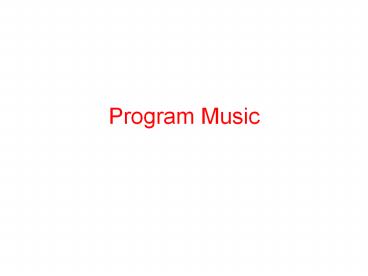Program%20Music - PowerPoint PPT Presentation
Title:
Program%20Music
Description:
Program Music Program Music Revival of program music in the late 19th century (late Romantic period.) Program music: materials & techniques are employed with the ... – PowerPoint PPT presentation
Number of Views:204
Avg rating:3.0/5.0
Title: Program%20Music
1
Program Music
2
Program Music
- Revival of program music in the late 19th century
(late Romantic period.) - Program music materials techniques are
employed with the intent of depicting an
extra-musical phenomenon. - For example
- A dramatic incident
- A poetic image
- A visual object
- An element in nature
3
- These things not only provided the general
suggestive impulses, but also became the
dominating ideas in the musical composition. - Other music composed during this time was called
absolute music. - Music conceived by the composer understood by
the listener without reference to extra-musical
features. - Program music extends back into the medieval
Renaissance eras.
4
Hector Berlioz1803-1869
5
- Grenoble, France
- Father wanted him to be a doctor, but it didnt
happen. - He spend more time at opera houses music halls.
- Berlioz fell in love with Harriet Smithson, an
English actress she was playing Ophelia in
Hamlet when Berlioz saw her. - He tried to meet her but was rejected as a
lunatic. - He continued studying music on his 5th attempt,
he won the prestigious Prix de Rome. (1830)
6
- Also in 1830, he finished his major only
widely-known composition, Symphonie Fantastique. - The symphony reflected his passion for
Smithson. - After hearing it, she was so impressed that she
married him. - Several years later though, they separated
(stormy relationship.) - Berlioz had difficulty in getting his works
performed. - He believe in BIG productions (200 instruments in
orchestra 300 singers in the chorus rather
impractical.)
7
- As a conductor, he added new instruments to the
orchestra. - He wrote some pieces for new redeveloped
instruments. - His greatest contribution to music getting sound
out of an orchestra (orchestration.) - Many of Berliozs ideas were grandiose proved
to be impractical for the time period. - Tone color was more prominent in his music than
melody harmony. - In 1844, he wrote an important treatise on
orchestration tone color.
8
- 3 characteristics of Berliozs music
- Passionate emotionalism
- Daring experimentation
- Rich imagination
- Berlioz wrote many dramatic symphonies, many on
the works of Shakespeare some on the works of
Goethe (story of Faust.) - Dramatic symphony similar to the oratorio not
religious in nature. - His major works are immense dramatic.
9
Major Works
- Symphonie Fantastique
- Romeo Juliet (dramatic symphony)
- King Lear Overture
- Beatrice et Benedict (opera)
- Waverly Rob Roy Overtures (based on novels by
Sir Walter Scott) - Harold in Italy (symphony based on a poem by
Byron.)
10
Symphonie Fantastique
11
- 5 Movements
- Reveries, Passions
- A Ball
- Scene in the Country
- March to the Scaffold
- Dream of the Witches Sabbath
12
Background Story
- A young musician poisons himself with opium in a
fit of lovesick despair its not enough to kill
him, just make him sick. - He has strange visions that are transformed into
musical thoughts images. - His loved-one becomes a melody (an idee-fixe a
fixed idea or fixation.) - This melody will appear in all 5 movements when
the musician thinks of the loved-one.
13
- The idee-fixe is also known as a signature theme.
- It is a theme (melody) or motto that is repeated,
with or without variation during a musical
composition. - ?The idee-fixe gives the piece musical unity
since it appears in each movement. - ?The orchestra portrays a wide range of images
emotional states.
14
Part I Reveries, Passions
- He recalls the soul-sickness, depressions,
groundless joys he experienced before he first
saw his love one. - Music then reflects the volcanic love that she
suddenly inspired in him. - Swirling sounds indicate the frenzied suffering,
jealous rages he experiences - The music also shows his returns to tenderness
his religious consolations.
15
Part II A Ball
- Waltz-like flavor
- He encounters his beloved at a party (music
sounds like the tumult of a brilliant party.) - Harps percussion
- Violintremolo
- Pay attention to the finale.
16
Part III Scene in the Country
- Slow, pastoral movement.
- Gentle calm
- Country scenery, quiet rustling of the trees
gently brushed by the wind - Gives the young musician an unaccustomed calm.
- The movement ends on a note of loneliness.
17
Part IV March to the Scaffold
- Scaffold guillotine
- He dreams he has killed his loved one is
condemned to death. - Rather somber fierce then brilliant solemn
- Has a military sound to it as the young composer
is marched to his death. - The idee-fixe returnshe sees his loved one in
the crowd and thenCHOP the blade of the
guillotine strikes.
18
- Bassoons play the melody
- Sound effects depicting elements of the story
- Listen for the snarling sound made by the
trombone.
19
Part V Dream of a Witches Sabbath
- Noises represent ghosts, sorcerers, monsters,
witches other types of ghouls there are
groans, bursts of laughter, distant cries. - He sees himself in the midst of this frightful
gathering, which turns out to be his funeral. - The beloved melody appears again, but it has no
character or nobility it is trivial, mean,
grotesque. - She has come to take part in the devilish orgy.
20
- Listen for the funeral knell (bells tolling at
midnight) - There is a parody of a Dies Irae (from the
requiem Day of Wrath) - The witches dance a round dance that is
supposed to sound like a fugue, which combines
the funeral knell the Dies Irae.































